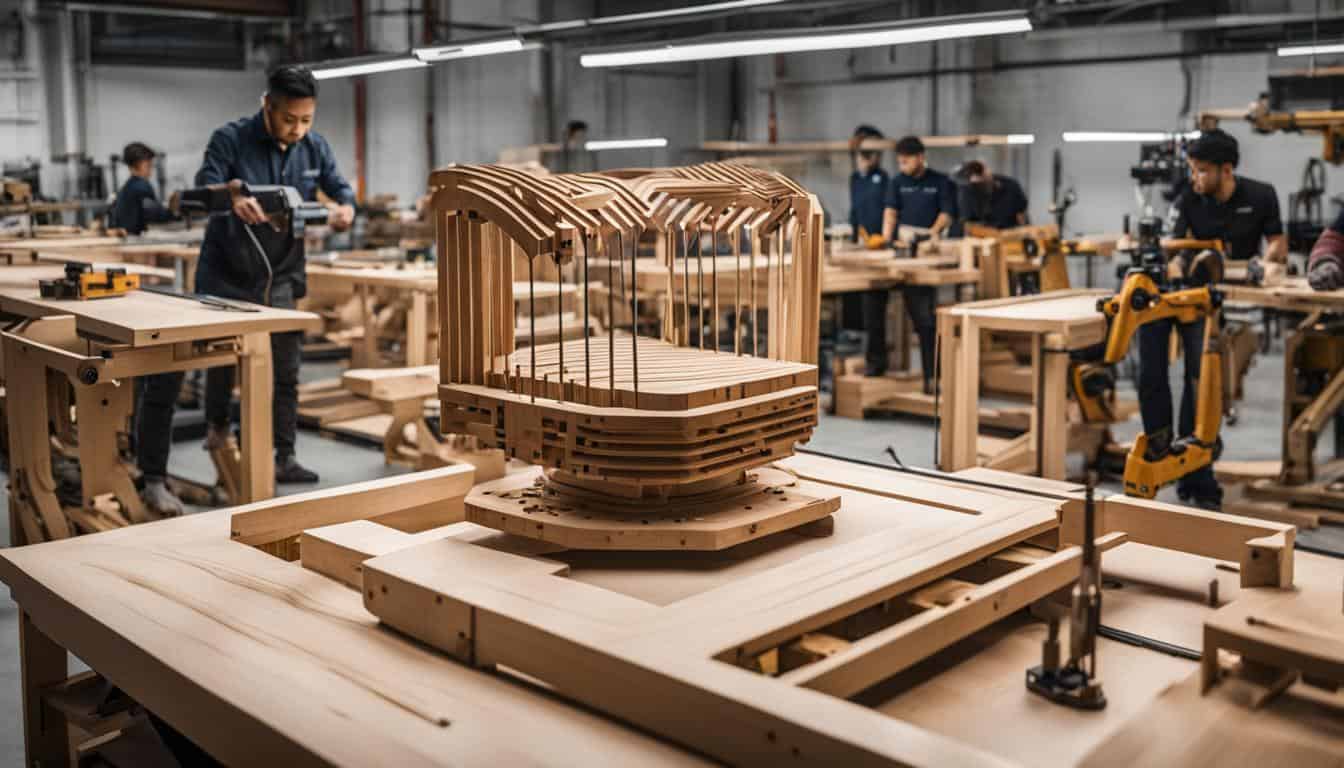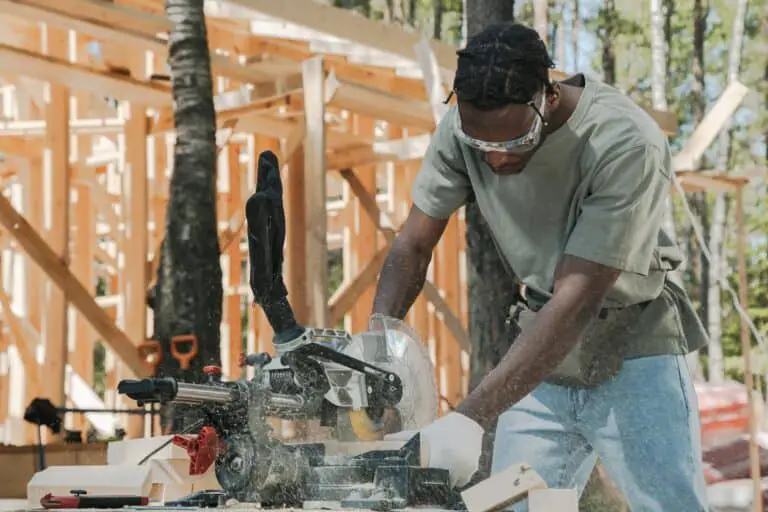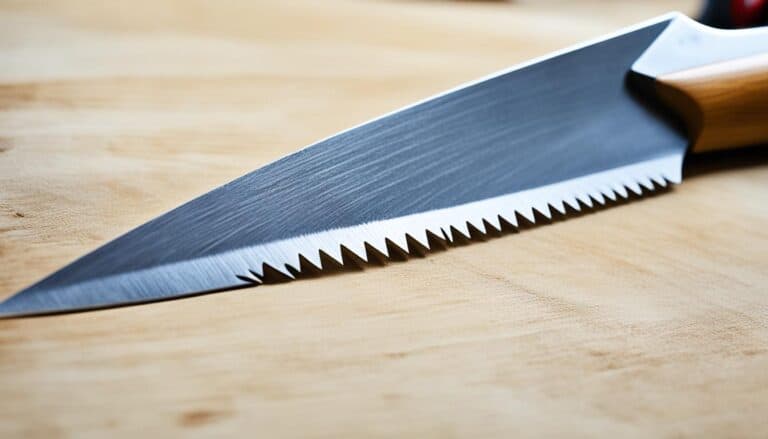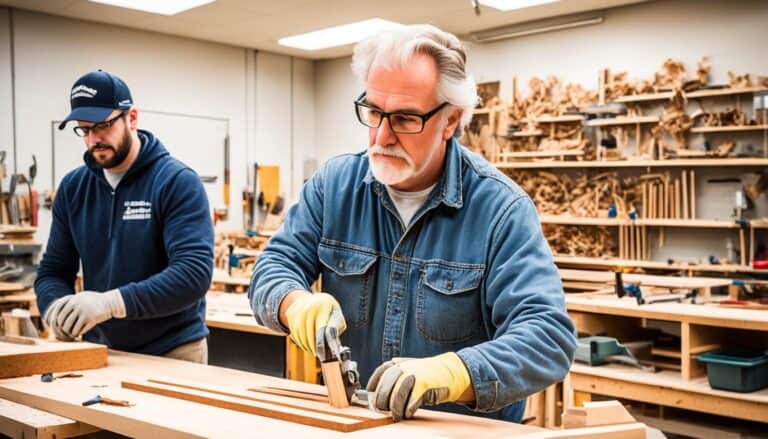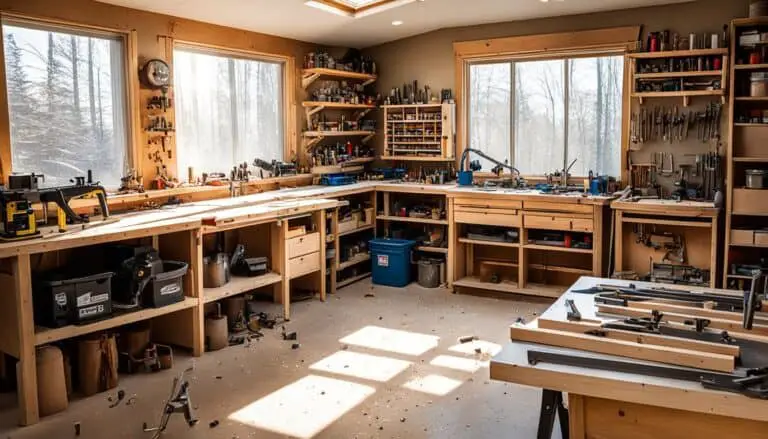Woodworking, a craft steeped in tradition, is experiencing a remarkable transformation with the advent of artificial intelligence (AI). With its unmatched efficiency and precision, AI is merging traditional craftsmanship with cutting-edge technology, opening up new possibilities for woodworkers. But how exactly is AI revolutionizing the woodworking industry? What benefits does it bring to this age-old craft? Let’s delve into the world of AI and explore the exciting applications and solutions it offers to woodworkers.
Key Takeaways:
- AI brings unparalleled efficiency and precision to the woodworking industry.
- Woodworkers can enhance productivity, streamline processes, and create exciting partnerships between craftsmanship and technology through AI.
- AI can be utilized for tasks such as precise framing measurements, clean lumber cuts, design and planning, material selection and optimization, precision cutting and carving, and sanding and finishing.
- Challenges of integrating AI in woodworking include the initial investment, workforce adaptation, data privacy and security concerns, and technical challenges.
- Hacoa, a woodworking company in Japan, has successfully blended traditional craftsmanship with AI and machine learning, creating unique and valuable wooden products.
How Can AI Be Used in Woodworking?
AI applications in woodworking have opened up new opportunities to enhance productivity and precision in the industry. Woodworkers are now able to leverage AI technology to improve their processes and achieve remarkable accuracy in their work.
Woodworking machines with AI capabilities can execute tasks with high precision, relying on accurate input data from users. This enables woodworkers to accomplish various tasks with greater efficiency and accuracy, resulting in enhanced productivity and quality of work.
Precision Framing Measurements
AI technology enables woodworking machines to perform precise framing measurements. By analyzing input data and using advanced algorithms, these machines can accurately determine the dimensions required for framing structures, ensuring a perfect fit and alignment.
Clean Lumber Cuts
With AI-enabled woodworking machines, woodworkers can achieve clean and accurate lumber cuts. The machines analyze the wood properties and make precise calculations to ensure the required cuts are executed flawlessly, minimizing waste and maximizing material utilization.
Design and Planning
AI technology plays a crucial role in design and planning processes in woodworking. Woodworkers can utilize AI-powered tools, such as computer-aided design and computer-aided manufacturing (CAD/CAM) systems, to create intricate and personalized woodwork designs. These systems assist in generating precise designs and optimizing production plans.
Material Selection and Optimization
AI-driven software can assist woodworkers in material selection and optimization. By considering project budgets and requirements, AI can recommend the most appropriate wood types and provide cost-effective cutting plans. This optimization helps woodworkers reduce waste, improve resource utilization, and make informed decisions about material selection.
Precision Cutting and Carving
AI can be integrated with CNC machines to achieve precision cutting and carving in woodworking. These AI-enabled machines dynamically adjust cutting parameters, ensuring every cut and carve is executed flawlessly with unmatched precision. This level of accuracy enables woodworkers to produce intricate and complex designs.
Sanding and Finishing
AI’s role in sanding and finishing is crucial for achieving consistent quality in woodworking. Robotic sanding systems, powered by AI, can detect and rectify surface irregularities, ensuring a flawless final product. By automating this process, woodworkers can achieve consistent results and improve the overall aesthetic appeal of their woodwork products.
By integrating AI into various aspects of woodworking, such as precision framing measurements, design and planning, material selection and optimization, precision cutting and carving, and sanding and finishing, woodworkers can unlock new levels of efficiency and precision in their work.
Next, we will explore in more detail how AI-powered design and planning tools are shaping the woodworking industry.
Design and Planning with AI
When it comes to woodworking, design and planning play a crucial role in creating visually stunning and personalized woodwork designs. With the advent of AI-powered tools, such as automated CAD/CAM systems, woodworkers now have access to revolutionary technology that enhances their creative capabilities.
Automated CAD/CAM systems leverage the power of AI to streamline the design and planning process in woodworking. These systems enable woodworkers to bring intricate concepts to life, with unparalleled precision and efficiency. By harnessing AI, woodworkers can turn their creative visions into unique and personalized woodwork designs.
One of the key benefits of using AI-powered design tools is the ability to explore a wide range of design possibilities. These tools analyze data, patterns, and textures to generate innovative design options that push the boundaries of traditional woodworking. This allows woodworkers to create one-of-a-kind pieces that captivate and inspire.
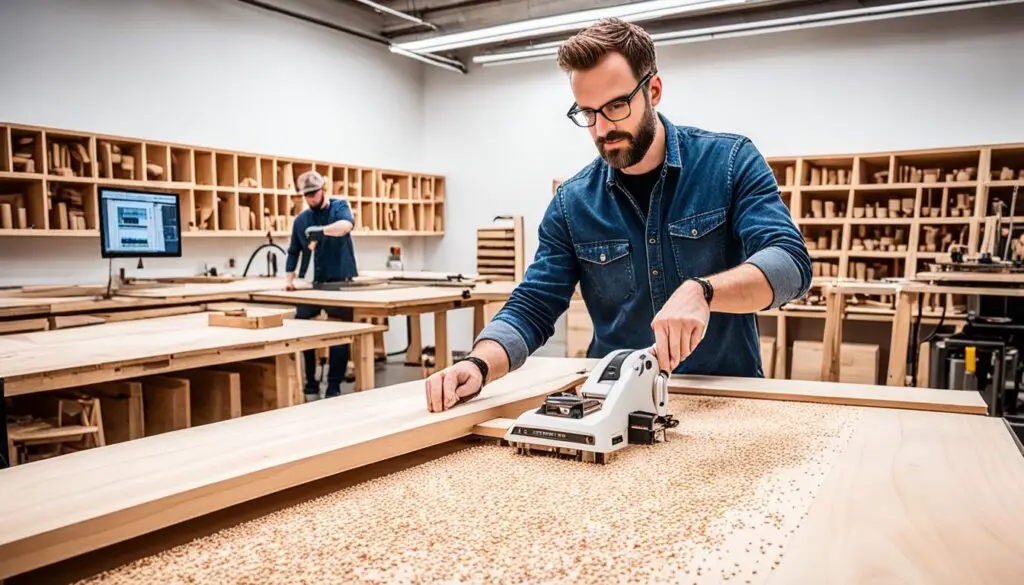
With automated CAD/CAM systems, woodworkers can also experiment and iterate quickly, making design changes effortlessly. This accelerates the design process, reduces the margin for error, and ultimately saves valuable time and resources.
The personalized woodwork designs made possible by AI-powered tools not only showcase the craftsmanship and creativity of the woodworker but also cater to the unique preferences of their clients. Whether it’s custom furniture, intricate carvings, or bespoke interior elements, AI-powered design elevates woodworking to a new level of personalization and customer satisfaction.
| Benefits of AI-powered design in woodworking |
|---|
| Enhanced creative capabilities |
| Efficient exploration of design possibilities |
| Rapid iteration and design changes |
| Personalized woodwork designs |
By embracing AI-powered design tools, woodworkers can push the boundaries of traditional woodworking, creating unique and visually stunning pieces that leave a lasting impression.
Quote:
“AI-powered design tools in woodworking enable us to create intricate and personalized woodwork designs that cater to the unique preferences of our clients. The possibilities are truly endless.”
Material Selection and Optimization with AI
In the woodworking industry, the process of selecting the right materials and optimizing projects for efficiency and cost-effectiveness is essential. With the advancements in technology, AI-driven software has emerged as a valuable tool to aid woodworkers in these crucial tasks.
AI-driven software utilizes machine learning algorithms to analyze project budgets and requirements, recommending the most appropriate wood types and providing cost-effective cutting plans. By inputting specific parameters into the AI software, woodworkers can optimize resource utilization and reduce waste, ultimately leading to more efficient production processes and substantial cost savings.
One of the key benefits of AI-driven software for material selection is the ability to provide precise recommendations based on extensive data analysis. By leveraging large datasets of wood characteristics, the software can identify the ideal wood types that meet both the functional and aesthetic requirements of a project. This ensures that woodworkers are equipped with the right materials to achieve the desired outcome.
Additionally, AI-driven software offers cost-effective cutting plans that minimize waste and maximize resource utilization. By considering factors such as wood dimensions, project specifications, and material costs, the software can generate cutting plans that optimize material usage, reducing the overall expenses associated with the project.
Sustainable Impact of AI in Woodworking
By optimizing material selection and cutting plans, AI-driven software contributes to the sustainability of the woodworking industry. Woodworkers can reduce the amount of waste generated during the production process, minimizing their environmental footprint and promoting sustainability.
Furthermore, cost-effective cutting plans enable woodworkers to make efficient use of available resources, preventing unnecessary overconsumption and reducing the demand for new materials. This reduction in resource consumption aligns with the principles of sustainable woodworking, promoting responsible practices and long-term environmental preservation.
Case Study: AI-driven Material Selection at Hacoa
To illustrate the effectiveness of AI-driven material selection in woodworking, let’s take a look at the case of Hacoa, a renowned woodworking company in Japan. Hacoa has successfully integrated AI into their material selection process, revolutionizing their production efficiency and product quality.
“With the help of AI-driven software, we have been able to determine the most suitable wood types for each project, considering factors such as durability, appearance, and budget constraints. This has immensely improved our ability to deliver exceptional craftsmanship while optimizing our use of resources.” – Toshihiro Takeda, Co-founder of Hacoa
Hacoa’s success in implementing AI-driven material selection showcases the immense potential and benefits of integrating AI into woodworking processes. By leveraging AI technology, woodworkers can unlock new levels of efficiency, precision, and sustainability in their craft.
| Benefits of AI-driven Material Selection | |
|---|---|
| 1. Enhanced precision in material selection | |
| 2. Cost-effective cutting plans | |
| 3. Optimization of resource utilization | |
| 4. Reduced waste and environmental impact | |
| 5. Improved production efficiency |
By embracing AI-driven software for material selection, woodworkers can elevate their craftsmanship, streamline their processes, and drive greater sustainability within the woodworking industry.
Precision Cutting and Carving with AI
When it comes to precision cutting and carving in woodworking, the integration of artificial intelligence (AI) with computer numerical control (CNC) machines is transforming the industry. By harnessing the power of AI, woodworkers can achieve flawless execution in their work, thanks to dynamic cutting parameters that ensure accuracy and precision every step of the way.
AI-enabled CNC machines have the ability to adjust cutting parameters dynamically, responding to real-time information and making automatic adjustments as needed. This level of adaptability ensures that every cut and carve is executed flawlessly, resulting in impeccable craftsmanship and stunning end products.
By leveraging AI in cutting and carving processes, woodworkers can improve overall accuracy and achieve a higher level of precision in their work. This enhanced level of precision allows for intricate and complex designs to be executed with ease, pushing the boundaries of what can be achieved in woodworking.
| Benefits of Precision Cutting and Carving with AI | Enhanced Accuracy | Improved Efficiency | Expanded Design Possibilities |
|---|---|---|---|
| Achieve unparalleled accuracy in every cut and carve | Streamline workflow and reduce human error | Unlock new creative possibilities with intricate designs | |
| Consistent and flawless execution of complex patterns | Spend less time on manual adjustments and fine-tuning | Efficient production of intricate woodwork projects | |
| Precision in reproducing intricate designs | Increase productivity and project turnaround time | Precision cutting and carving of unique shapes and forms |
By combining the expertise of woodworkers with the accuracy and efficiency of AI-powered CNC machines, flawless execution in precision cutting and carving is now within reach. Woodworkers can push the boundaries of what can be achieved in woodworking, delivering intricate designs and impeccable craftsmanship that captivate and inspire.
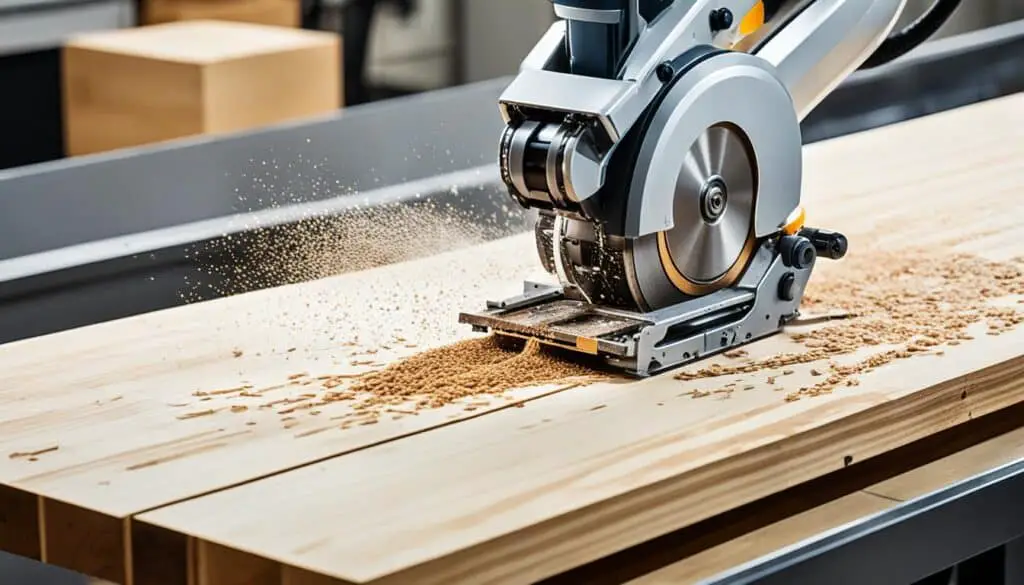
Sanding and Finishing with AI
In the woodworking industry, the sanding and finishing stage is crucial in achieving a flawless final product. This is where AI automation comes into play, offering woodworkers the opportunity to elevate the quality and aesthetics of their woodwork products.
Robotic sanding is an automated system that has been programmed with AI capabilities. These robots are designed to detect and rectify surface irregularities, ensuring a smooth and even finish. By incorporating AI in the sanding and finishing processes, woodworkers can achieve consistent quality, eliminate human error, and enhance the overall appeal of their woodwork products.
Robotic sanding offers several advantages over traditional sanding methods. Firstly, it increases productivity by reducing manual labor and allowing woodworkers to focus on other important tasks. Secondly, it ensures a higher level of precision and accuracy, as the robotic system follows preset patterns and parameters. Lastly, it provides a uniform finish across multiple pieces, ensuring a cohesive and professional look for projects.
By leveraging AI in the sanding and finishing stage, woodworkers can achieve a flawless final product, saving time and effort while delivering exceptional craftsmanship and visual appeal.
Benefits of AI Automation in Sanding and Finishing:
- Consistent quality: AI-powered robotic sanding ensures that every piece is sanded evenly and to the desired level of smoothness, resulting in a consistent and professional finish.
- Increased efficiency: Robotic sanding automates the process, reducing the time and effort required compared to traditional manual sanding methods.
- Greater precision: AI-controlled robots follow pre-programmed patterns and parameters, ensuring precise sanding and a higher level of accuracy.
- Improved safety: By removing the need for manual sanding, AI automation minimizes the risk of injuries and accidents, creating a safer working environment.
Transforming Woodwork with Robotic Sanding:
The integration of AI automation in sanding and finishing has had a significant impact on the woodworking industry. It allows woodworkers to produce flawless and visually appealing woodwork products consistently, meeting high standards of quality and customer expectations.
Whether it’s sanding intricate designs or achieving a smooth surface on large-scale projects, robotic sanding powered by AI provides woodworkers with the tools they need to create exquisite and flawless woodwork products.
Challenges of AI-Assisted Woodworking Jobs
Integrating AI in woodworking presents various challenges. From initial investment to technical hurdles, woodworkers need to navigate these obstacles to fully harness the benefits of AI technology.
1. Initial Investment
One of the challenges of adopting AI in woodworking is the significant initial investment required. Incorporating AI tools and machines can come with a hefty price tag, especially for small businesses with limited budgets. The costs include not only the technology itself but also the necessary training and infrastructure upgrades.
2. Workforce Adaptation
Embracing AI in woodworking requires woodworkers to adapt to new ways of working. They need to learn new skills and techniques that integrate craftsmanship with AI capabilities. This adjustment can be challenging, as it involves breaking away from traditional methods and embracing technology as an essential part of the woodworking process.
3. Data Privacy and Security
AI relies on vast amounts of data to operate effectively. Woodworkers face the challenge of ensuring the privacy and security of sensitive data while leveraging AI technology. Protecting customer information, trade secrets, and proprietary designs becomes increasingly crucial as reliance on AI grows in the industry.
4. Technical Challenges
AI technology is not without its technical challenges. Glitches and malfunctions can disrupt workflow and impact productivity. Woodworkers must have contingency plans in place to address potential downtime caused by technical issues. Additionally, keeping up with advancements in AI technology and ensuring compatibility with existing systems pose ongoing challenges.
“Integrating AI in woodworking comes with its fair share of challenges. From the significant initial investment to technical glitches, woodworkers need to navigate these obstacles to fully embrace the benefits of AI.”
Addressing the Challenges
Despite these challenges, it is essential for woodworkers to overcome them to stay competitive in the evolving industry. With careful planning, strategic investment, and a commitment to continuous learning, woodworkers can harness the power of AI to enhance their craft and drive success.
In the next section, we will explore a success story of a woodworking company that has successfully integrated AI into their traditional craftsmanship, highlighting the potential rewards and opportunities that AI brings to the woodworking industry.
The Success Story of Hacoa: Integrating AI and Woodworking
Hacoa, a renowned woodworking company in Japan, has achieved remarkable success by seamlessly integrating AI and machine learning into their traditional craftsmanship. This innovative approach has enabled Hacoa to create precise and consistent wooden products that have garnered recognition worldwide.
By leveraging AI and machine learning technologies, Hacoa’s artisans analyze the unique characteristics of different types of wood with unparalleled accuracy. This deep understanding allows them to create exquisite and functional wooden products that exceed customer expectations.
What sets Hacoa apart is their ability to blend traditional and modern techniques, combining the craftsmanship of skilled woodworkers with the precision and efficiency of AI. This harmonious collaboration allows for the creation of distinctively beautiful and high-quality wooden items.
The Blend of Tradition and Technology
“At Hacoa, we believe in the harmonious blend of tradition and technology. Our commitment to preserving the artistry of woodworking while incorporating AI and machine learning has been the driving force behind our success.” – Hacoa Founders
The integration of AI and machine learning enables Hacoa to produce consistent and flawless wooden products. The technology assists in identifying the ideal wood type for each project, ensuring optimal strength, durability, and aesthetic appeal. With precise measurements and calculations, Hacoa achieves unparalleled accuracy in their designs and cuts.
One of the key advantages of AI and machine learning in woodworking is the ability to analyze vast amounts of data and patterns. This allows Hacoa to create wooden products with unique textures and finishes, showcasing the natural beauty of the wood. The combination of AI and woodworking expertise results in a level of craftsmanship that is both contemporary and timeless.
Hacoa’s Precision and Consistency
The incorporation of AI and machine learning has revolutionized Hacoa’s woodworking process, enabling precise and consistent production. This revolution has been made possible through the utilization of AI-powered systems that analyze wood characteristics, grain patterns, and textures. By interpreting this data, Hacoa’s artisans can ensure the highest quality and consistency in their wooden products.
The use of AI not only enhances the precision of Hacoa’s craftsmanship but also streamlines their production processes. With AI-driven automation, tasks that were once time-consuming and prone to human error can now be performed efficiently and accurately. This optimization allows Hacoa to deliver exceptional wooden products in a timely manner.
| Benefits of AI Integration in Woodworking |
|---|
| 1. Precise and consistent wooden products |
| 2. Enhanced productivity and efficiency in woodworking processes |
| 3. Streamlined production through automation |
| 4. Access to unique wood textures and finishes |
| 5. Preservation of traditional craftsmanship while embracing technological advancements |
Through the successful integration of AI and woodworking, Hacoa has become a global leader in producing precise and consistent wooden products. Their commitment to blending traditional artistry with modern technology has set them apart in the competitive woodworking industry.
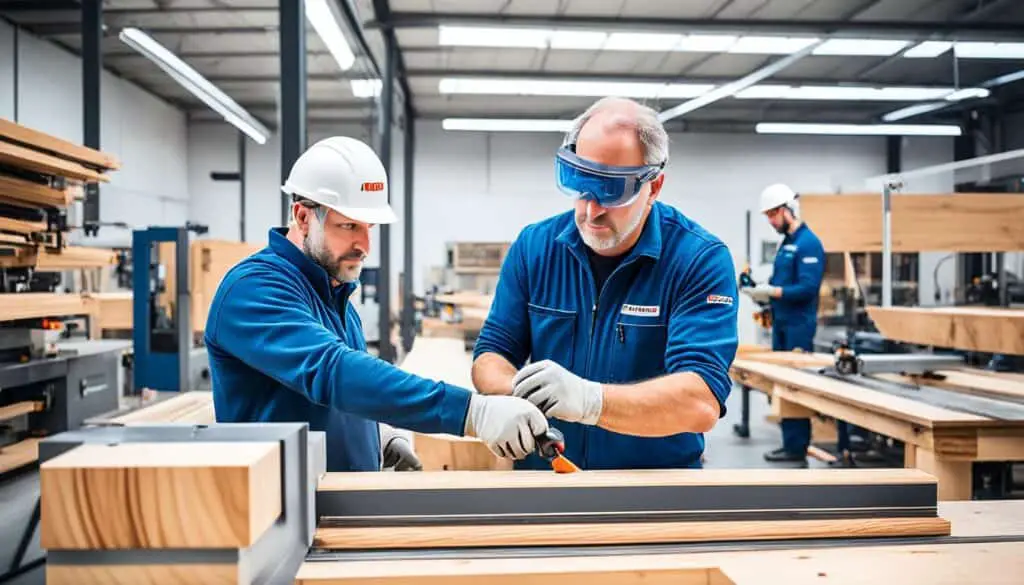
Image: Hacoa’s meticulous craftsmanship and AI integration produce precise and consistent wooden products.
The Journey of Hacoa: A Blend of Tradition and Technology
Hacoa, founded by woodworkers Toshihiro Takeda and Ryohei Ikebe, is located in Hida, a town recognized for its rich woodworking history. In order to stand out in a fiercely competitive market, Hacoa made the bold decision to incorporate artificial intelligence (AI) and machine learning into their woodworking process. By merging the essence of traditional craftsmanship with cutting-edge technology, Hacoa has successfully created an exquisite collection of wooden products that are both unique and highly valuable.
The incorporation of AI in woodworking has allowed Hacoa to not only honor their heritage but also set themselves apart from their competitors. By leveraging AI-driven techniques, Hacoa has achieved a level of precision and sophistication that is unmatched in the industry. This integration of tradition and technology has resonated with customers worldwide, positioning Hacoa as a trendsetter and a benchmark for excellence in the woodworking industry.
As a result of their unwavering commitment to innovation, Hacoa has been able to produce a diverse range of wooden products that captivate customers with their exceptional quality and craftsmanship. From intricately designed furniture pieces to intricately carved accessories, each Hacoa creation showcases the harmonious blend of tradition and technology, turning every wooden product into a work of art.
The journey of Hacoa is a testament to the power and potential of AI in woodworking. By embracing AI, Hacoa has been able to not only preserve the legacy of woodworking but also push the boundaries of creativity and craftsmanship. Through their dedication to excellence and their ability to seamlessly integrate tradition with technology, Hacoa has established itself as a trailblazer in the industry, inspiring woodworkers around the world to embrace the limitless possibilities that AI can bring to their craft.
Hacoa’s Woodworking Process: Analyzing Patterns with AI
In their pursuit of creating unique and consistent wooden products, Hacoa employs a revolutionary woodworking process that involves analyzing the intricate patterns and textures of various wood types. Central to this innovative approach is their state-of-the-art WOOD X system, which leverages the power of artificial intelligence (AI) to unlock the full potential of woodcraft.
Using AI algorithms, Hacoa’s artisans can delve deep into the grain, knots, and natural imperfections of different types of wood, unveiling the hidden beauty within. By meticulously analyzing the patterns and textures, the WOOD X system enables Hacoa to achieve an unparalleled level of precision and consistency in their wooden creations.
Through this meticulous analysis, Hacoa’s skilled craftsmen can uncover the unique characteristics and potential of each piece of wood, allowing them to create bespoke and extraordinary wooden products. From intricate furniture designs to stylish home accessories, Hacoa’s innovative woodworking process shapes each piece with meticulous attention to detail.
“The WOOD X system has revolutionized our woodworking process, enabling us to delve beyond the surface and truly understand the personality of each individual piece of wood. This level of analysis and precision allows us to create wooden products that are not only visually stunning but also consistently superior in quality.”
By embracing AI and combining it with their traditional woodworking expertise, Hacoa has elevated their craftsmanship to new heights. The masterful union of technology and tradition is what sets Hacoa’s wooden products apart, making them truly one-of-a-kind.
As the WOOD X system continues to analyze patterns and textures, Hacoa remains at the forefront of innovation in the woodworking industry. Their dedication to producing unique and consistent wooden products has garnered them acclaim and admiration from customers worldwide.

Hacoa’s Success Amid Challenges
When Hacoa embarked on the journey of incorporating AI into their woodworking process, they encountered several challenges. The integration of AI required significant investments of time and resources to develop their AI and machine learning system. Additionally, they faced skepticism from traditionalists who questioned the compatibility of technology with traditional craftsmanship.
Despite these hurdles, Hacoa’s perseverance and commitment to innovation prevailed. They stayed true to their mission of blending traditional craftsmanship with cutting-edge technology, creating a unique approach that sets them apart in the woodworking industry.
What truly sets Hacoa apart is their loyal following. Their dedication to producing stunning and precise wooden products has garnered them a global customer base who appreciates the seamless integration of tradition and technology. Hacoa’s reputation for quality and craftsmanship has earned them a loyal following who admire their ability to deliver exquisite wooden creations.
“Hacoa’s relentless pursuit of combining traditional woodworking techniques with the power of AI has resulted in extraordinary creations that captivate both traditionalists and technology enthusiasts.” – Woodworking Magazine
Through their unwavering commitment to excellence, Hacoa has not only overcome the challenges they faced but emerged as a leader in the woodworking industry. Their success serves as an inspiration to other woodworking firms looking to embrace the potential of AI while honoring the craft’s rich tradition.
Hacoa’s story is a testament to the power of perseverance and the unwavering loyalty that can be achieved through innovative and exceptional craftsmanship.
Key Takeaways:
- Hacoa faced challenges when incorporating AI into their woodworking process, including the need for significant investments and skepticism from traditionalists.
- Despite these challenges, Hacoa persevered and gained a loyal following around the world.
- Their unique blend of traditional craftsmanship and cutting-edge technology has allowed them to create stunning and precise wooden products.
Hacoa’s Global Recognition
Hacoa’s products have gained global recognition and have been featured in prestigious design exhibitions and shows around the world. From Paris to New York and Tokyo, Hacoa’s creations have captured the attention of design enthusiasts and woodwork aficionados alike.
What sets Hacoa apart is their ability to showcase the perfect fusion of craftsmanship and technology in their products. Each item is meticulously crafted to embody precision, elegance, and functionality.
Whether it’s a beautifully designed desk organizer, a sleek smartphone stand, or a minimalist wooden clock, Hacoa’s products showcase the unparalleled craftsmanship and attention to detail that goes into every piece.
Customers worldwide appreciate Hacoa’s commitment to blending tradition with modern technology, resulting in timeless and unique wooden products that stand the test of time.
Design Exhibitions and Shows
Hacoa’s presence in design exhibitions and shows has provided a platform to showcase their exceptional woodwork products. Their participation in these events allows them to connect with a global audience and share their passion for the perfect harmony between craftsmanship and technology.
| Event | Location | Date |
|---|---|---|
| Maison&Objet | Paris, France | September 2022 |
| International Contemporary Furniture Fair (ICFF) | New York, USA | May 2022 |
| Design Tokyo | Tokyo, Japan | June 2022 |
Showcasing Craftsmanship and Technology
At these exhibitions and shows, Hacoa’s products steal the spotlight, captivating visitors with their exceptional craftsmanship and integration of technology. Each item reflects the perfect balance between traditional woodworking techniques and modern innovations, creating a truly remarkable experience.
Visitors have the opportunity to witness firsthand the precision and attention to detail that goes into each Hacoa product. The combination of natural wood materials and cutting-edge technology results in stunning pieces that not only enhance any space but also showcase the seamless integration of craftsmanship and technology.
Through their participation in design exhibitions and shows worldwide, Hacoa continues to gain recognition for their exceptional woodworking products. Their ability to seamlessly blend craftsmanship and technology sets them apart in the industry, making them a global leader and trusted brand for exquisite wooden creations.
The Impact of AI in Woodworking Beyond Hacoa
AI’s influence in the woodworking industry extends far beyond the success of Hacoa. The integration of AI systems brings about significant transformations to woodworking processes, enabling automation in manufacturing, advancing timber building design, and creating new job opportunities.
Automation in Manufacturing
AI systems have revolutionized manufacturing processes in woodworking. By automating tasks that were once labor-intensive and time-consuming, AI improves overall efficiency and productivity. These systems can execute repetitive jobs with precision, such as cutting, carving, and sanding, resulting in faster project completion.
| Automation Benefits in Manufacturing | Examples |
|---|---|
| Enhanced Efficiency | Automated material handling and tool switching |
| Improved Precision | AI-guided cutting and shaping |
| Increased Output | Optimized production workflows |
AI in Timber Building Design
The field of timber building design benefits greatly from AI integration. AI enables modular prefabrication, making construction faster, more cost-effective, and environmentally friendly. Furthermore, AI allows for the exploration and implementation of novel shapes, patterns, and structural solutions, unlocking a new level of architectural creativity.
New Job Opportunities
While some traditional woodworking jobs may be automated, the integration of AI in the industry creates a demand for new roles and skillsets. Woodworkers can focus on more complex tasks that require creative thinking and problem-solving, such as design customization, project management, and quality control. Additionally, AI technology development, maintenance, and operation open up opportunities for professionals in the AI field.
AI revolutionizes the woodworking industry by streamlining manufacturing processes, pushing the boundaries of timber building design, and creating new avenues for employment. By embracing the power of AI, woodworkers can unlock unprecedented levels of efficiency, precision, and innovation.
Continue reading to discover the AI tools available to woodworkers, empowering them to enhance their craft and drive exceptional results.
AI Tools for Woodworkers
Woodworkers can take advantage of various AI tools to enhance their woodworking processes. These innovative tools combine the power of artificial intelligence with woodworking expertise, streamlining and optimizing tasks to achieve outstanding results. By incorporating AI into their workflow, woodworkers can improve efficiency, precision, and overall productivity. Let’s explore a few essential AI tools that are revolutionizing the woodworking industry:
Wood Selector AI Guide
The wood selector AI guide is a valuable tool that assists woodworkers in choosing the most suitable wood for their projects. By analyzing project requirements, aesthetics, and specific characteristics of different wood types, the AI guide recommends the ideal wood for each unique project. This tool saves time and prevents costly mistakes by offering valuable insights and expert recommendations.
Wood Moisture Control AI Tool
Controlling wood moisture is crucial in woodworking to prevent warping, cracking, and other undesirable effects. The wood moisture control AI tool helps woodworkers understand and manage wood moisture levels accurately. By analyzing environmental conditions, wood density, and other factors, this tool provides real-time feedback and suggestions for optimal moisture control, ensuring the longevity and quality of the finished woodwork.
Woodworking Safety AI Tool
Safety is paramount in any woodworking project. The woodworking safety AI tool provides woodworkers with safety standards, guidelines, and best practices. By analyzing data from past incidents and industry regulations, this tool offers proactive safety recommendations, helping woodworkers identify potential hazards and take appropriate preventive measures. With the aid of AI, woodworkers can create a safe working environment and reduce the risk of accidents.
Wood Waste Management AI Tool
Minimizing waste and promoting sustainability is a priority in the woodworking industry. The wood waste management AI tool helps woodworkers optimize material usage and reduce waste generation. By analyzing project parameters and material availability, this tool offers efficient cutting plans, ensuring maximum utilization of resources. The wood waste management AI tool empowers woodworkers to minimize their environmental footprint and contribute to a greener future.
Mouldings and Profiles Selection AI Tool
Choosing the right mouldings and profiles is essential for achieving the desired aesthetic and functionality in woodworking projects. The mouldings and profiles selection AI tool assists woodworkers in selecting the most suitable options for their projects. By analyzing project specifications, design preferences, and compatibility factors, this tool offers a curated selection of mouldings and profiles that complement the overall design and enhance the final result.
These AI tools are revolutionizing the woodworking industry by offering unparalleled precision, efficiency, and creative possibilities. Woodworkers can leverage these tools to optimize their workflow, enhance safety standards, reduce waste, and create exceptional woodwork projects. By merging traditional craftsmanship with AI capabilities, woodworkers can unlock new levels of creativity, productivity, and success in their woodworking endeavors.
Conclusion
The incorporation of AI in woodworking is revolutionizing the industry, blending tradition and technology to unlock new levels of efficiency and precision. Woodworkers worldwide are embracing AI tools and machines to streamline their processes and achieve remarkable results. Despite the initial challenges, the future of woodworking is bright, as AI continues to reshape the industry.
By integrating AI into their practices, woodworkers can optimize productivity and reduce waste, leading to a more sustainable and environmentally friendly approach. The fusion of traditional craftsmanship with AI capabilities enables woodworkers to create innovative designs and unique woodwork products, captivating customers and driving the industry forward.
The future of woodworking lies in the seamless integration of tradition and technology, driven by the power of AI. As the woodworking industry continues to evolve, AI will play a vital role in transforming the built environment. Woodworkers can embrace this revolution, leveraging AI to enhance efficiency, precision, and creativity, ensuring a bright future for woodworking.
FAQ
What is the role of AI in woodworking?
AI plays a crucial role in enhancing productivity and precision in woodworking. It can be used for tasks such as framing measurements, lumber cuts, design and planning, material selection and optimization, precision cutting and carving, and sanding and finishing.
How does AI revolutionize the design and planning process in woodworking?
AI-powered tools, such as automated CAD/CAM systems, revolutionize the design and planning process in woodworking. These systems facilitate creative design processes and allow for the production of intricate and personalized woodwork designs.
How does AI help in material selection and project optimization in woodworking?
AI-driven software can recommend the most appropriate wood types and offer cost-effective cutting plans based on project budgets and requirements. This helps woodworkers optimize resource utilization and reduce waste, leading to more efficient production processes and cost savings.
How can AI improve precision cutting and carving in woodworking?
AI can be integrated with CNC machines to achieve precision cutting and carving in woodworking. AI-enabled machines adjust cutting parameters dynamically, ensuring flawless execution of every cut and carve.
What is the role of AI in the sanding and finishing stage of woodworking?
AI plays a crucial role in the sanding and finishing stage by using automated systems, such as robotic sanding, to detect and rectify surface irregularities, ensuring a flawless final product.
What are the challenges of integrating AI in woodworking?
Challenges include the initial investment in technology and human capital, workforce adaptation to new skills and approaches, data privacy and security concerns, and potential technical glitches requiring contingency plans.
How has Hacoa successfully integrated AI and woodworking?
Hacoa, a woodworking company in Japan, has successfully blended traditional craftsmanship with AI and machine learning. By analyzing the unique characteristics of different types of wood, Hacoa creates precise and consistent wooden products.
What challenges did Hacoa face when incorporating AI in woodworking?
Hacoa had to invest time and resources in developing their AI and machine learning system and faced skepticism from traditionalists. However, they persevered and gained recognition for their unique blend of tradition and technology.
How has Hacoa gained global recognition for their woodworking products?
Hacoa’s products have been featured in design exhibitions and shows around the world, showcasing their fusion of craftsmanship and technology. Their precision and consistency have earned them recognition and appreciation from customers worldwide.
What is the impact of AI beyond Hacoa in the woodworking industry?
AI has a broader impact in the woodworking industry, automating manufacturing processes, enabling predictive maintenance, and creating new job opportunities. It also facilitates modular prefabrication and allows for the use of novel shapes and patterns in timber building design.
What AI tools are available for woodworkers?
Woodworkers can leverage various AI tools, including the wood selector AI guide, wood moisture control AI tool, woodworking safety AI tool, wood waste management AI tool, and mouldings and profiles selection AI tool, to enhance their woodworking processes.


